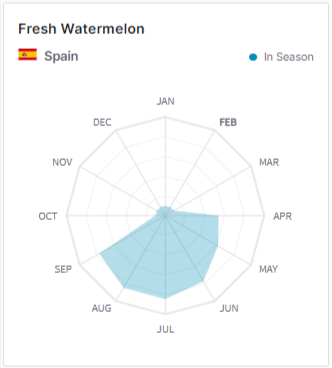Uncertainty Looms Over Upcoming Spanish Melon and Watermelon Campaign

The upcoming Spanish melon and watermelon campaign is facing many challenges ahead in 2023 due to an estimated reduction in the harvest of around 15-20%, according to the forecast made by AVA-Asaja-Almería. Official figures for Spain's watermelon production in 2022 are not published, with estimates showing redundancy to 971,000 MT. This reduction is expected to be more pronounced in the west of Almeria. In contrast, in areas such as Níjar, a slight increase in watermelon surface area is anticipated, mainly due to the reduction in the price of tomatoes, where farmers decided to shift to watermelon and melon production.
Almeria, located in the province of Andalusia, is a significant agricultural-producing region in Spain, contributing to more than 52% of total Andalusian exports. Between January and October 2022, fruit and vegetable export from this region reached € 2,898M, representing 21.6% of the national total. Almeria is also where agricultural export grew the most in the mentioned period, at over 17.2% YoY. Melons and watermelons are among the top ten agricultural commodities in overall export from Andalusia. In the first ten months of 2022, the export of melons and watermelons increased by 6% compared to the same period of the previous year, with a total export value of € 332M.
Top 10 Tradeflows of Spanish Watermelons

Source: Tridge
Europe is the top foreign destination for Andalusian fruit and vegetable exports. However, there is a gradual shift to North America, particularly to Canada, where sales more than doubled (+110%) to USD 20.8M in 2022, making it the fastest-growing market among the top 20 destinations. In the United States, sales increased by 7.3% YoY to USD 11.8M according to FEPEX data.
Seasonality of Fresh Watermelon in Spain

Source: Tridge
The Outcome of Spanish Melons and Watermelons
Despite the diminished acreage of melons and watermelons, Spain is expected to dominate the global export market. The total area under watermelons based on Faostat data is around 21,600 ha, while melons are grown at 18,500 ha in Spain. Export quantities are following the trend of decreased acreage, with a decline of over 4.5% from 2019 to 430,760 MT In 2021. A negative trend is expected to continue in 2023, driven by increased input cost and water issues, like in 2022, where water per cubic meter has reached prohibitive quotations. Adverse weather in terms of severe drought, as well as spring frost and sand storms, made production, which is mostly on open fields demanding and costworthy. In the previous year, all these factors, along with strikes in Spain contributed to a price hike that was reported by a Tridge data analysis: Several Factors Driving the Melon Price in Spain Uncontrollably High. Taking into account last year's price data, farmers may still decide to maintain watermelon and melon production. Nevertheless, with the first melons arriving in April, the price for these commodities is expected to be higher due to lower supply availability and input costs that are remaining a significant threat to the profit margin of farmers.




